Starting a new social media presence from scratch can feel like a big challenge.
As I launch my own side project right now, I’m poring over my Buffer analytics as I start at the very beginning to build a following everywhere. Things look very different in these early days as compared to what it must feel like for big, established names who have thousands or millions of fans.
Here on the Buffer blog, we’ve written about some great strategies to get your first 1,000 followers that I’ve been following closely. I also wondered if it might inspire me a bit to look at how Buffer itself built a social following back in the early days of the app, particularly on Twitter.
This would have been pretty tricky to do just a few months ago, but Twitter’s new full tweet index allows you to search through every public tweet since the social network’s launch in 2006. Another neat trick: Using the Discover tool, you can discover the first tweet of any Twitter account. For instance, Buffer’s first tweet was short and a bit mysterious:
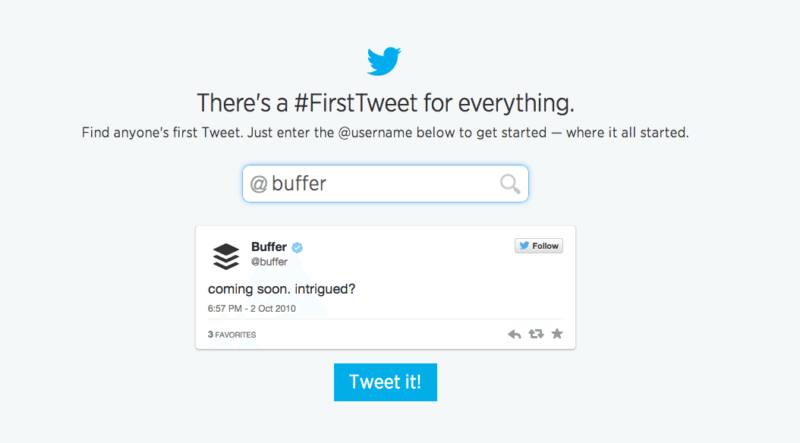
Social media moves fast, so not all these tactics may be exactly what might help and work today, but there are some constants, and those ideas are what I tried to focus on most.
Maybe this reflection can help others just starting out to get a sneak preview of some ideas that have worked for others (and avoid those that don’t). Here’s what I learned from going back in time to see what we did right—and what we might have done differently—in those early days.
What worked well
Reaching out to influencers to build awareness
When you’re just starting out and no one knows who you are yet, one strategy to build up your following is to reach out to people whom you respect and admire in your field who are better known than you.
Buffer took to this tactic of outreach to social media influencers right away, reaching out to people like Guy Kawasaki and Aaron Lee by writing about them in a very authentic way.
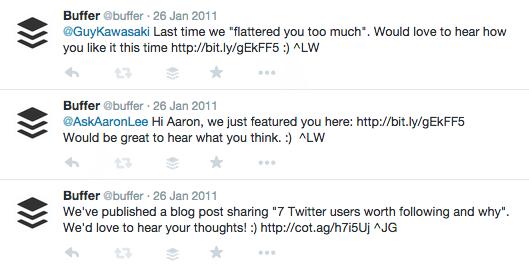
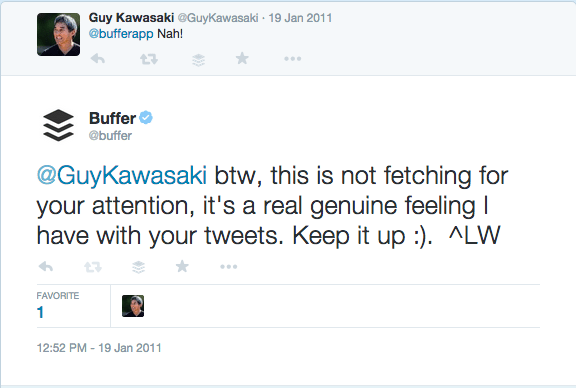
Try it for yourself: How to Build an Outreach Strategy to Earn More Social Shares
Involving the community
From the start, Buffer related to our audience much the same way we do now–as people we respect, enjoy and love to learn from. Early posts show the team reaching out for feedback, learning from those with experiences to share and working to get honest answers to early community members’ questions and requests.



Try it for yourself: The Science of Building a Strong, Lasting Community on Social Media
Sharing inside details transparently
Long before we had a transparency dashboard full of openness goodies, we had a belief in sharing early and often what was going on at Buffer.
Tweets that share the latest news of Buffer challenges and features were easy to find, and Buffer’s CEO Joel more or less lays out the origin of Buffer in his post Idea to Paying Customers in 7 Weeks: How We Did It.



Try it for yourself: The 4 Benefits of Transparency We’ve Seen at Our Startup
Celebrating milestones
Here is one that hadn’t occurred to me, but I’m excited to give it a try now! From the start, Buffer kept a close eye on both number of users and number of total posts sent through our social media management tools. Each new milestone was an opportunity to share transparently with the community and celebrate together.



Try it for yourself: Share milestones like number of Facebook fans, Twitter followers, blog subscribers, customers, or email list subscribers with your community to make them part of your growth and celebration.
Working for press coverage
Getting press coverage is a key element of any new business’ journey. Buffer’s first bit of coverage was this short piece on The Next Web, followed quickly thereafter by a few more lovely press mentions.


In this post, you can see Leo doing some great hustling to get the press awareness that would later begin to pay off in the form or articles about Buffer—and later, press syndication.

I asked Leo how he and Joel managed to get press coverage in the early days, and he tracked down the exact method that eventually led to Buffer’s own feature on The Next Web: some comments he posted on an article there about features Twitter should have.

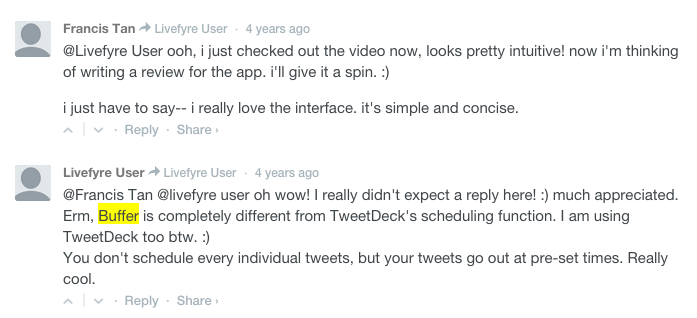
Try it for yourself: The 12-Step Insider’s Guide To Getting Press Coverage via Forbes
Focusing on creating happy customers
Taking great care of the customers who entrust part of their social media strategy to us is something we feel strongly about at Buffer, and the focus has been there since Day 1.
An early tweet shows the Zappos customer service model was an inspiration, and some chats with Buffer’s first few customers show lots of the personal attention that we still strive for today, even with 2 million plus customers.




Try it for yourself: The Complete Guide to Using Social Media for Customer Service
Sharing useful resources through content curation
Passing along the best, most useful material to our patrons, customers, fans, or followers—aka content curation—is a tried-and-true way of gaining a strong and appreciative following. The Internet is a busy place, and trusted curators are worth their weight in gold.
Buffer discovered this early, regularly adding curation on social media topics into the overall mix of news, tool updates and miscellaneous other content.

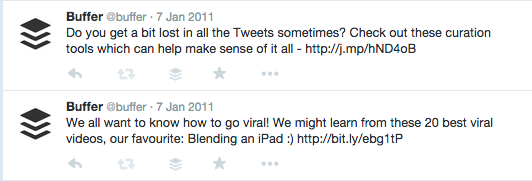
Try it for yourself: The Busy Person’s Guide to Content Curation: A 3-Step Process for Your Blog, Newsletter, or Timeline
Admitting to mistakes
The last cool element that I noticed from Buffer’s first tweets was a willingness to admit to our mistakes—a trait that we have fallen back on time and time again. In this small example, Leo does an awesome job of delivering personal apologies to followers after an unexpected flood of tweets.
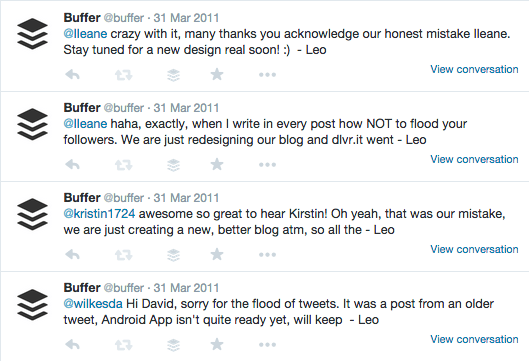
I have a feeling that setting the precedent here of admitted to and apologizing for our own screw-ups laid a good bit of the groundwork we would come to rely on a bit later when Buffer faced a hack in 2013.
Good things tend to come out of this philosophy. In our case, we got a much more secure tool and a deeper connection with our community, among many other benefits.
Try it for yourself: The Art of Admitting Failure via Harvard Business Review
What we might do differently today
Off-topic posts
The more we learn about social media (and we’re always learning!), the more important consistency seems to be. Consistency of social media voice and tone, consistency of social media frequency, and—perhaps most especially—consistency of content.
We didn’t always know these lessons, and the Buffer account’s early days show a brand still finding its voice. A few posts, like these two, stood out as a telltale sign that we had perhaps yet to find consistency:


Try this instead: Achieve Perfect Social Media Volume, Quality, Voice, and Topics Every Time with the Consistency Pizza
“Selling” messages
So much of marketing—especially in the scrappy, early days—seems to be about the hustle.
And with good reason! When no one has heard of you and you feel you have something valuable to offer, it’s hard not to want to shout it from the rooftops and get your brand known by any means necessary.
It feels like that enthusiasm is what might have motivated the tweets below:

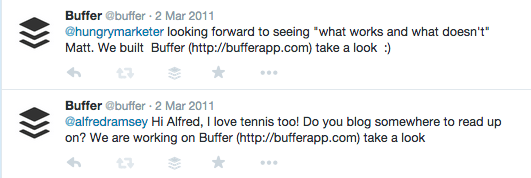
Messages like these may well have played a bit part in getting Buffer on people’s radar. I’m not sure that we would approach them the same way if we were starting out today.
In Reinventing Organizations, a book that’s become quite important to Buffer recently, Frederic Laloux writes that evolved marketing is less about metrics and conversions and more about putting out a product and message that feels useful and right and letting the rest fall into place naturally.
Essentially, marketing boils down to this statement: This is our offer. At this moment, we feel this is the best we can possibly do. We hope you will like it.“
As we try to absorb this philosophy more deeply, we’ve grown into the idea that marketing doesn’t have to explicitly sell a product. It can also be so simple and so useful as to scarcely seem to exist at all.
Try this instead: The Content Marketing Manifesto by Rand Fishkin
Contests and giveaways
Frequent visitors to the blog may have noticed that we very seldom do any sort of contest or giveaway, but that wasn’t always the case. In the early days of Buffer, as seen in the tweets below, contests were a part of our marketing strategy.
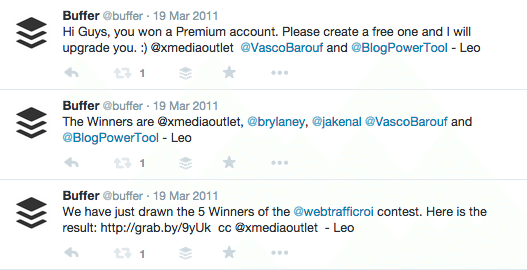
As we evolved, we later determined that other activities seem to provide us with better results and phased this element out of our strategy.
In this way, this one isn’t so much a mistake at all as it is a healthy and natural part of the evolution of any brand as you learn what works and what doesn’t. Perhaps if we tried a contest again today, things might be quite different!
Try this instead: How to Run a Successful Social Media Sweepstakes via Social Media Examiner
It was a fascinating journey to see how Buffer has evolved from its very first tweets. I hope some of these lessons might be applicable to your brand, as well.
If you happen to take a look at your earliest social media posts, I’d love to hear what discoveries you come across, too! What social tactics and strategies worked best, and which ones wouldn’t you recommend again? Let me know in the comments!
Try Buffer for free
190,000+ creators, small businesses, and marketers use Buffer to grow their audiences every month.



